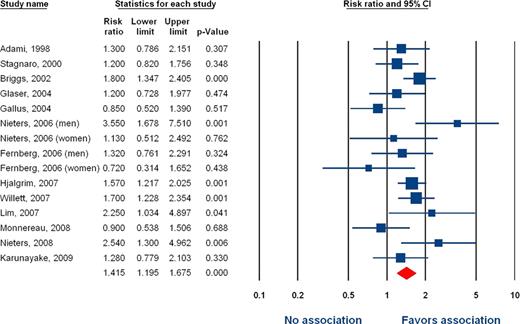Abstract
Abstract 2560
Few risk factors for the development of Hodgkin lymphoma (HL) have been described. A relationship between smoking and the subsequent development of HL has been suggested from previous reports; however, the available data are largely conflicting. The primary objective of this meta-analysis of observational studies is to evaluate the potential epidemiologic relationship, if any, between smoking and HL.
We searched MEDLINE from January 1, 1960 to June 30, 2010 for observational studies on the association between smoking and HL in adults using the keywords “smoking” and “lymphoma”. Prospective cohort studies and case-control studies that reported relative risks (RR), hazard ratios, or odds ratios with 95% confidence intervals (CI) were included. Literature search, study selection and data gathering were performed independently by the two of authors. Cases were subdivided in ever smokers and current smokers and analyzed separately. Fixed-effect model (FEM) and random-effects models (REM) were used to assess the combined outcome of individual studies. The outcome measured in our study is reported as RR (95% CI). REM was used, if needed, to account for heterogeneity between studies. Heterogeneity was evaluated using the Cochrane Q and I2 statistics. Publication bias was assessed by direct observation of a funnel plot as well as trim-and-fill statistics. Quality of the studies was assessed using the Newcastle-Ottawa scale.
Our initial search rendered 577 articles. After reviewing the titles and abstracts, 36 papers were selected for full-text retrieval and reference list search, from which 4 prospective and 11 case-control studies were included in the final analysis. All studies were of high quality with both case-control and prospective studies averaging a score of 8 on the Newcastle-Ottawa scale. When pooling all studies, ever smokers had a RR of 1.20 (95% CI 1.07–1.34; p=0.001); there was no heterogeneity between studies or dissemination bias. Current smokers had a RR of 1.42 (95% CI 1.20–1.68; p<0.001, Figure); there was mild heterogeneity between studies (Q=28.5, I2=45.8%, p=0.046) but no dissemination bias was identified. Based on case-control studies, ever smoking was associated with a RR of 1.16 (95% CI 1.02–1.31; p=0.02) while current smoking was associated with a RR of 1.39 (95% CI 1.14–1.69; p<0.001). Based on prospective studies, ever smoking had a RR 1.40 (95% CI 1.10–1.77; p=0.005) while current smoking had a RR 1.49 (1.02-2.18; p=0.04).
In both retrospective and prospective studies, there is a 20% increased risk of developing HL in those patients who have ever smoked. However, the risk increases to 42% in those who were current smokers at time of diagnosis of HL. Our findings confirm a previously reported association between smoking and the development of HL, giving additional support in favor of smoking cessation. The lymphomagenic mechanism of smoking is currently unclear but could be related to a direct carcinogenic effect of tobacco-related agents or the immunomodulatory effect of smoking.
No relevant conflicts of interest to declare.
Author notes
Asterisk with author names denotes non-ASH members.


This feature is available to Subscribers Only
Sign In or Create an Account Close Modal